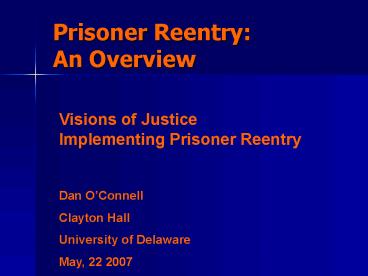Prisoner Reentry: An Overview - PowerPoint PPT Presentation
1 / 17
Title:
Prisoner Reentry: An Overview
Description:
Visions of Justice. Implementing Prisoner Reentry. Dan O'Connell. Clayton Hall ... Visions of Justice: Implementing Prisoner Reentry. Daniel J. O'Connell. May ... – PowerPoint PPT presentation
Number of Views:217
Avg rating:3.0/5.0
Title: Prisoner Reentry: An Overview
1
Prisoner ReentryAn Overview
Visions of Justice Implementing Prisoner Reentry
Dan OConnell Clayton Hall University of
Delaware May, 22 2007
2
Road Map
- What is Reentry?
- Who is coming home?
- If were going to do something we need to know
who were dealing with. - Exiting Criminal Careers
- Because that is really the end goal, right?
3
Reentry Defined
- A process The process of exiting a correctional
institution and returning to the community after
serving a significant portion of a criminal
sentence, often coupled with ongoing community
supervision. - A State An individual can often be considered to
be at a point, or state, in a cycle of removalgt
reentrygt removal (etc.). Sometimes called
churning. - Churning At the community level, when large
numbers of people are churning, it moves beyond
simply impacting individuals and their families
to impacting labor markets, social support and
overall community cohesion.
4
Reentry as a ProcessSome questions
- If reentry is a process, when does it start?
- When an inmate leaves the institution?
- Before that?
- How long?
- When does it end (when has a person reentered)?
- When the inmate gets to his or her house?
- A month later?
- When they finish probation?
- A year?
- Ten Years?
- If we cant agree on when reentry starts or ends,
it is unlikely that we are clear of what it
MEANS.
5
More questionsWhat does the process entail?
- Two approaches
- Increase the price of crime by making it less
attractive or accessible - Tougher probation/parole conditions
- More supervision
- Make non-crime more attractive or accessible
- Treatment programs
- Access to employment, education etc
6
Who is coming home?
- 650,000 State Prison inmates per year
- Many more county jail inmates who have served
lesser sentences - How long must one serve to be considered
reentering? - Mostly male.
- Under-employed
- Under-educated
- Drug addicted (BUT MOSTLY CLEAN)
- At high risk for HIV/ HCV
- Reentering offenders die at a rate 12 times the
general population in the first two weeks after
release
7
Race of People Exiting Prison to Parole in the U.S
Bureau of Justice Statistics
8
Current Offense of People Entering Parole in the
U.S
Bureau of Justice Statistics
9
Recidivism of Released Prisoners, 1994 (Percents)
Bureau of Justice Statistics
10
Three Year Rearrest Rate by Number of Prior
Arrests (Percents)
61 of those with 16 or more prior arrests were
rearrested in the FIRST YEAR
Bureau of Justice Statistics
11
Exiting Criminal Careers Arrest Distribution by
Age, 2005 National Uniform Crime Reports
Adapted from Paternoster and Bushway
12
Laub and Sampson, 2004
13
Exiting Criminal CareersWhat we know
- DISISTANCE IS NORMAL
- The question is WHEN, not IF they desist
- Employment counts
- Family/ social support count
- Education counts
- People tend to drift in and out of crime
- Periods of crime tend to be associated with
periods of drug use. - Exiting addiction careers is associated with
exiting criminal careers.
14
Hooks for Change
- We cannot assign people to employment, sobriety,
good relations and social support. - People must seek out these things.
- They must be
- Available- are there jobs? Treatment? Support?
- Desired- Does the person WANT these things?
- Attainable- is the person employable?
- Seen as life changing not all hooks work.
15
What we DONT KNOW
- DIRECTION Maybe exiting criminal careers causes
work, good families and fewer drugs. - Why do some people find these things sooner
than others? - What is it about family, work, etc that enables
people to cease crime? - What can we do to engage more reentering people
in these activities? - HINT Incarceration AND being a criminal are the
very things that make people less attractive
candidates for the very things that are
associated with desistance.
16
What we DO know
- The end goal or reentry is to facilitate the
process of exiting the criminal career. - Be it trying to help the offender
- Supervise the probationer/parolee
- Incarcerate the inmate
- We are all working towards the same end.
17
Further reading
- When Prisoners Come Home Parole and Prisoner
Reentry (Studies in Crime and Public Policy) by
Joan Petersilia, Oxford University Press, USA
(2003). - But They All Come Back Facing The Challenges Of
Prisoner Reentry by Jeremy Travis Urban
Institute Press (2005). - Making Good How Ex-Convicts Reform Rebuild
Their Lives by Shadd Maruna American
Psychological Association (APA) 1st edition
(2001). - Shared Beginnings, Divergent Lives Delinquent
Boys to Age 70 by John H. Laub and Robert J.
Sampson Harvard University Press (2003). - Prisoner Reentry And the Life Course The Role of
Race And Drugs by Daniel J. O'Connell LFB
Scholarly Publishing (2006). (But I warn you,
its mostly statistics ? ). - Gender, Crime and Desistence Toward a Theory of
Cognitive Transformation. American Journal of
Sociology, v104 p990-1064 (2002)































